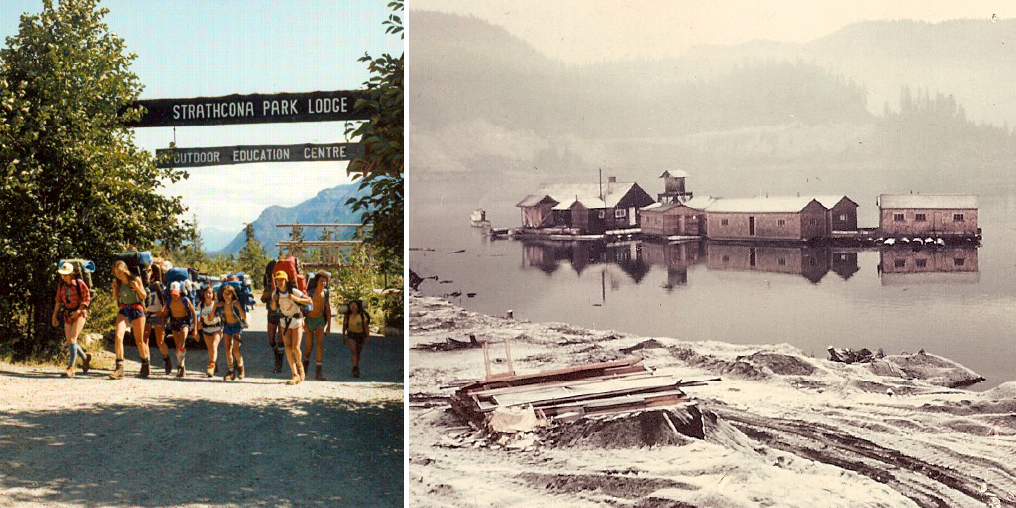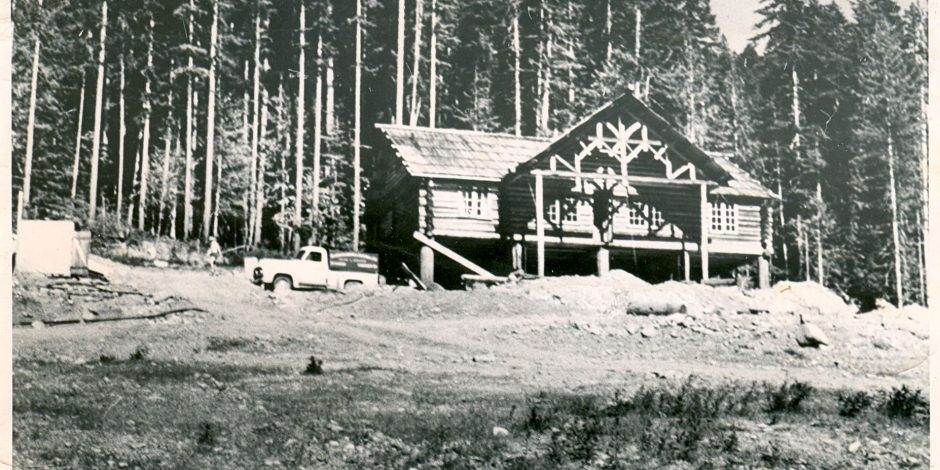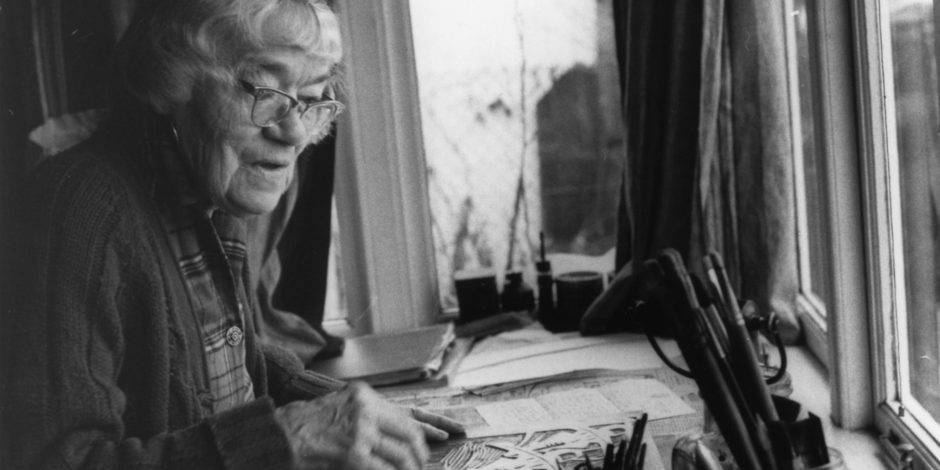When you drive west along the winding road that skirts Lower and Upper Campbell Lakes, as it hugs the rock face of central Vancouver Island, you might believe you are in the proverbial ‘middle of nowhere,’ when suddenly, Strathcona Park Lodge and Outdoor Education Centre looms in front of you like a warm hug after a long journey in the cold. Like many a curious traveller, you may wonder who thought to put this welcoming haven on the roadside. The story behind how the lodge came to be is wonderfully intriguing and is the result of indomitable pioneering spirit.
In 1959, two Campbell River teachers, Jim and Myrna Boulding, were initially looking for a property to start a summer boy’s camp and Myrna’s father, Wallace Baikie, had what he thought to be the ideal location at Upper Campbell Lake; 165 acres received from the BC Power Commission in 1958 in exchange for property he lost when the Strathcona Dam was constructed. At the time, hundreds of hectares of land, as well as buildings, were going to be lost in the resultant flooding. Wallace was determined, however, to save a beautiful cedar lodge on the west side of Upper Campbell Lake and purchased it from the Power Commission. He and his brothers Harper and Jack, who in those years logged in the area, conceived of the idea of putting enormous cedar logs under the building to create a raft so that the entire structure would begin to float as the valley was flooded. Their technique worked; the lake level rose and after about a year of lurching about the lake, the building finally settled on Wallace’s land. The lodge was pulled uphill with cable and winches to the top of the property, and the raft that it had floated on became a boat dock.
Several bunkhouses and cabins that had been part of the Baikie brothers’ logging camp were also floated across the lake. Situated along the shoreline of the lake, these cabins have been through several incarnations as both staff and guest accommodations.
The boy’s camp did not materialize. Instead, Myrna said the couple ‘stumbled into tourism’ because passersby, on the then gravel road, saw the lovely lodge and asked if they could stay, and soon guests were offered the opportunity to go salmon fishing on the west coast with Jim. Still, events were to transpire that lead the Bouldings into outdoor education. A famous guest, Burl Ives, suggested they create an outdoor education school based on the Outward Bound school his son was then attending. The Bouldings were also inspired and encouraged by their friend, the renowned author and conservationist Roderick Haig-Brown, and First Nations spokesman George Clutesi, who both spoke at a seminar held at the Lodge in 1968. The following year, Myrna and Jim, with their three children, went to England to attend graduate studies in rural and recreational planning, and while there visited Outward Bound schools.
The experience in Britain consolidated their ideas on outdoor education and they began developing programs that could be offered to schools. In 1972, the Bouldings left their teaching positions, and in 1973, the first school group arrived. While they were there, sadly, the beautiful main lodge building burned down. At the same time, a new building, meant to stable the horses kept at the property, was already under construction and the office and dining room/kitchen moved there. Once this Outdoor Centre was completed, the Administration building was constructed.
Over the years, various staff members and volunteers have worked on construction for the Lodge buildings. Jim even enticed some of his former students to come out to the property to help with construction. Since Strathcona’s inception, most of the staff have both lived and worked at the Lodge and many even built their own cabins. One of the larger cabins was even built by a Katimavik group.
The Bouldings encouraged gardening, bread making, using wood heat and other forms of self-sufficiency that would contribute to their idea of a rural resource village. This concept, inspired from a drawing by architect and mountaineer, Rob Wood, meant Strathcona could be a prototype; a commune where the practical application of modern, rural survival could be explored. Jim worked at instilling in students and staff an understanding of their role in this village and in the neighbouring environment. Before “environmental awareness” became fashionable, Jim was promoting stewardship of the land, teaching wilderness survival and minimal impact on the environment.

In a letter to the Vancouver Sun, Myrna wrote: “This is a special place offering a truly Canadian experience. The staff feel strongly that the way to save the wilderness is to encourage a low impact visitor industry. I feel that, for most people, wilderness trips are very therapeutic. I’ve seen people come here and definitely change their priorities. Perhaps they come because they are ready for a change…”
Initially outdoor education instructors came mainly from Britain, but by the mid 1970s the Bouldings created an Apprenticeship program so that instructors could be trained at the Lodge. This program evolved into COLT – Canadian Outdoor Leadership Training – a course recognized worldwide today.
Although the Bouldings lived simply, they struggled to keep the Lodge on solid financial footing. They diverted income from summer guest revenue to keep the outdoor education end of the operation going and applied for funding wherever possible.
They received help from family members, such as Myrna’s aunt Nancy Brown, who came in the late ‘70s to help with the two youngest children who were born after the Boulding’s return from England. Nancy stayed for 13 years, first working in the office, then the kitchen.
“We have five children,” Jim wrote in a 1979 letter, “And have a difficult but interesting life.”
Jim and Myrna’s difficulties were compounded when Jim fell ill with pancreatic cancer in 1984. After two years of illness, he passed away on May 17, 1986. Three days later, Myrna accepted the Heaslip Award for Environmental Stewardship from the United Nations Environment Program in recognition of their work with the environment.
Jim Boulding became somewhat of a legend in his own time, and because he was a large man with strong opinions and an exuberant personality, he invariably left an impression on people. He is remembered for his willingness to tackle obstacles big and small, yet he was aware that it required the efforts of many people to do so. One of his most memorable remarks was, “I’m kind of an ordinary guy, so I’ve learned to surround myself with creative people.”
It took many dedicated people and Myrna’s determination to keep the Lodge operating after his passing. Her eldest son Jamie, who during the period of Jim’s illness was attending UBC, came back to help at the Lodge.
Myrna and Jamie were joined in 1992 by Jamie’s wife Christine Clarke, who coordinates the financial end of the business, and has been a strong and valuable influence in guiding the programs that the Lodge offers. Jamie oversees COLT and the physical plant – a formidable task since the Lodge is ‘off the grid’ and produces its own power using a Peltham wheel and recently installed solar panels. There is no cellular service in the Lodge’s vicinity and telephone communication is by radiophone.
In a beautiful setting, surrounded by mountains and looking into the Elk River Valley, Strathcona Park Lodge and Outdoor Education Centre today is world-renowned for its outstanding programs and ethical awareness and practices.
Author note: Myrna, now in her mid-eighties, continues to live at her home on Lodge property and in 2009 wrote the history of the Lodge: Survival Strathcona Style, On the Grid and Off the Edge. The book was reprinted in 2019 in time for the Lodge’s 60th Anniversary.
Catherine Gilbert was the principal editor for Myrna’s book and her new book Strathcona Provincial Park: A Journey Back to Nature will be released by Heritage House Publishing in Spring 2021.


